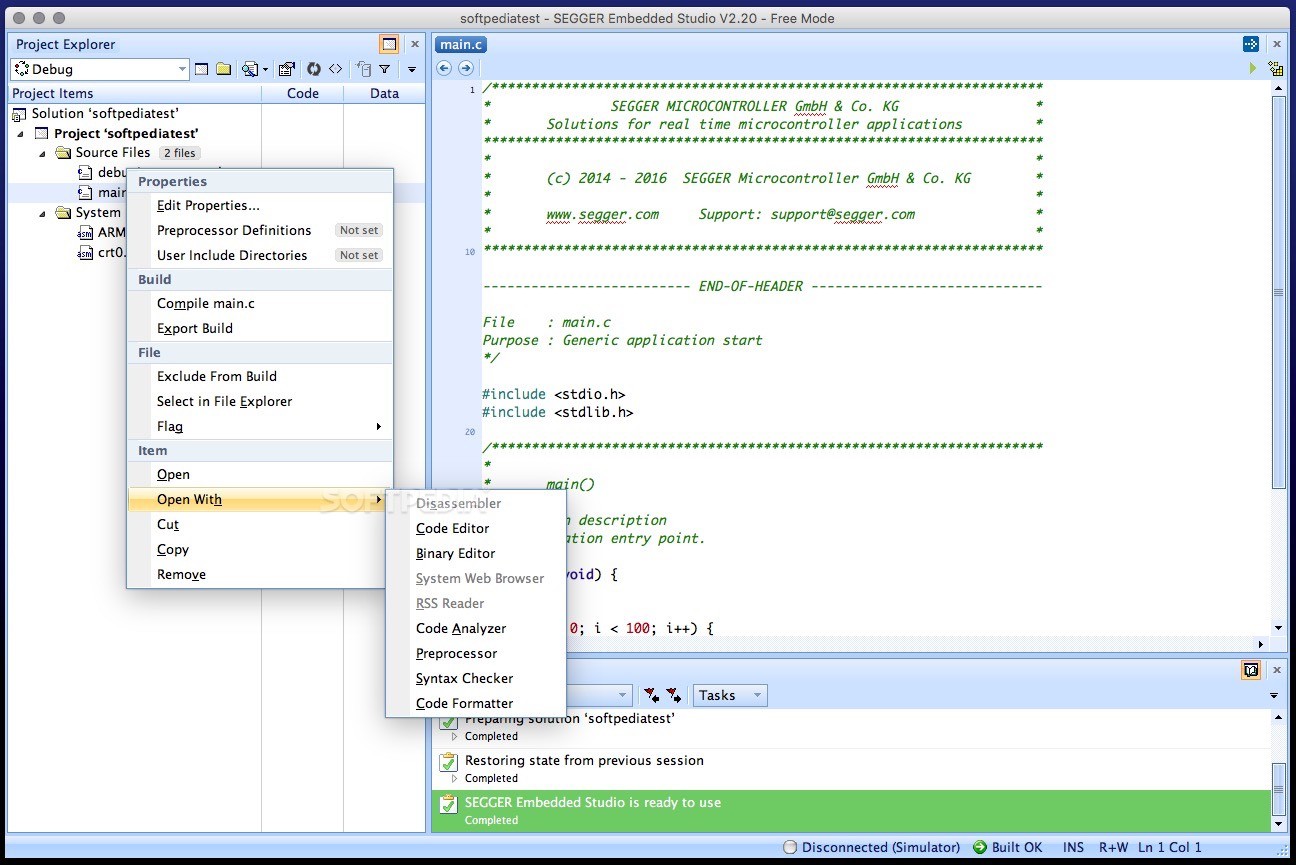

- #SEGGER EMBEDDED STUDIO MAC HOW TO#
- #SEGGER EMBEDDED STUDIO MAC GENERATOR#
- #SEGGER EMBEDDED STUDIO MAC REGISTRATION#
- #SEGGER EMBEDDED STUDIO MAC PROFESSIONAL#
Looking at the tutorial I believe that Memory Map for the Thingy should be: Running nrfutil settings display on thingy_v1.1.0.HW_1.0.hex gives me this: Bootloader DFU Settings:

I have tried a few combinations (also referencing the ble_app_thingy_gcc_nrf52.ld and secure_dfu_gcc_nrf52.ld) but they didn’t seem to make any real difference.
#SEGGER EMBEDDED STUDIO MAC HOW TO#
I have found an interested thread in which there is some suggestion on how to modify the flash_placement and MemoryMap: /./. ld file), I realized that SRAM may instead start from 0x20004068, therefore I modified the Linker->Section Placement Macro as follows: START_FLASH=0x1F000 Having checked the Keil project (and the. I tried a few other things but with no luck. Output/ble_app_thingy_s132_pca20020 release/Obj/drv_motion.o: In function `mpulib_init’: Output/ble_app_thingy_s132_pca20020 release/Obj/drv_speaker.o: In function `drv_speaker_tone_start’: Region `UNPLACED_SECTIONS' overflowed by 4096 bytes
#SEGGER EMBEDDED STUDIO MAC PROFESSIONAL#
It is specifically designed to provide users with everything needed for professional embedded C programming and development: An all-in-one solution providing stability and a continuous workflow for any development environment. Now I get a list of errors which start from the following: Output/release/Exe/ble_app_thingy_s132_pca20020.elf section `.bootloaderSettings' will not fit in region `UNPLACED_SECTIONS’ Embedded Studio is a powerful C/C++ IDE (Integrated Development Environment) for microcontrollers. I have followed step by step the instructions here: /./, which worked for the project ble_app_beacon but not for the Thingy project.Īfter that, I followed the instructions from the README here: /./Nordic-Thingy52-FW and in particular step 5.įinally, I “Excluded from Build” RTT_Syscalls_KEIL.c and “Add Existing File” /Applications/SEGGER Embedded Studio 3.24/samples/SEGGER_RTT_Syscalls_SES.c
#SEGGER EMBEDDED STUDIO MAC REGISTRATION#
“Version 5 outperforms even my own expectations.”Įmbedded Studio can be downloaded without registration and used free of charge for educational and non-commercial purposes, as well as evaluated (without code size, feature, or time limit) on all platforms.įor more information about Embedded Studio or to download and use it, please go to: įor more information on a blinky in less than 100 bytes, please see the SEGGER blog article: Every byte counts – the 100-byte blinky challenge.I am trying to port the Thingy project (ble_app_thingy_s132_pca20020) to Segger Embedded Studio on a Mac and it proved to be not an easy task, in fact I have hit a few road blocks. Our linker, startup code, runtime library and debugger are all tuned to get the most out of a microcontroller,” said Rolf Segger, founder of SEGGER. In balanced optimization mode, it produces code that is as small as it is fast.
#SEGGER EMBEDDED STUDIO MAC GENERATOR#
Our compiler uses Clang with a new code generator developed directly by the SEGGER software engineering team. I have never seen a toolchain that produces such small programs, especially out-of-the-box, created by the project generator. “This new version of Embedded Studio is truly groundbreaking. Just like SEGGER’s SystemView and Ozone platforms, Embedded Studio can be used on Windows, Linux and macOS operating systems – in keeping with the company’s cross-platform philosophy. Terminal output (printf) can be done in real time using RTT, SWO or semi-hosting with host-side formatting, keeping even the standard ‘Hello World’ program to no more than a few hundred bytes. All components are designed from the ground up for use in embedded systems and work seamlessly to help generate extremely small programs.Ī program which blinks an LED – a ‘blinky’ – on a typical Cortex-M microcontroller unit can be written in C or C++, with a total size of less than 100bytes. The newly released SEGGER Embedded Studio V5 for Arm processors comes with the company’s Compiler, Linker, Runtime and Floating-Point libraries included.


 0 kommentar(er)
0 kommentar(er)
